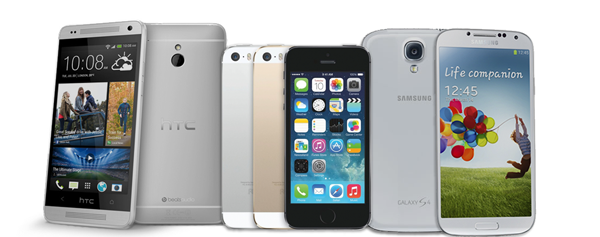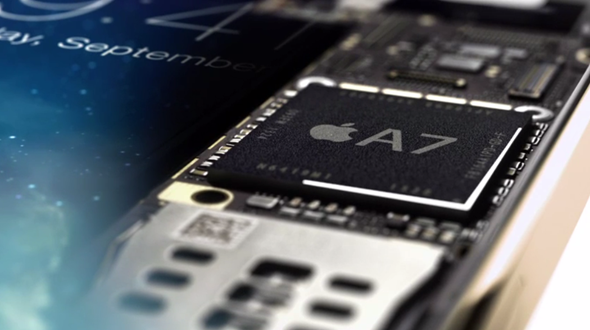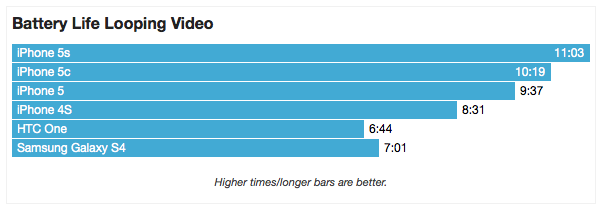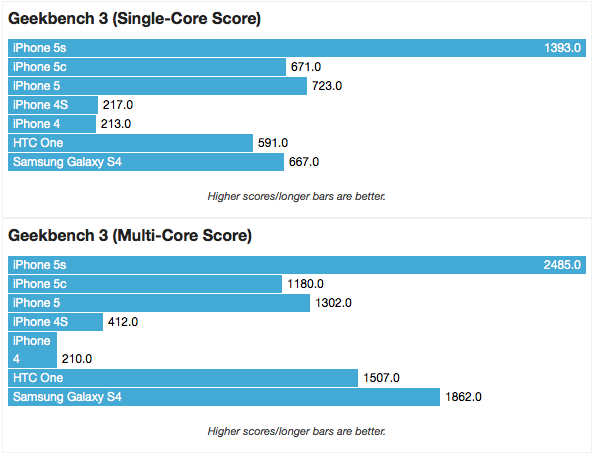
I noticed the other day when reviewing the new iPhone 5S that it has somewhat underwhelming numbers on its tech specs sheet. Dual core in a world of quad core phones, only 1GB of Memory, still only a 1500mAh battery1. Compared to it's competitors, these numbers are not groundbreaking at first glance. What gives?

The processor of your computer or smartphone is the engine that drives everything. Since the first commercially available microprocessor (the Intel 4004 in 19712), the number of transistors built in computer chips has gone from twenty-three hundred to about five thousand…thousand…thousand. This is Moore's law, the exponential growth of computer technology, according to which microchips double in power every two years. Amazingly, this prediction has stayed more or less true since its origin in 1965. So it's safe to say that bigger is always better, right? Yes, but it's only half the story.
As tech companies continue to push the envelope with performance, consumers are seeing bigger and bigger numbers in mobile processors, memory, storage, and batteries. As of the date of this article, it is possible to buy a smartphone with a Quad (!) core processor pushing almost 2GHz, with 2GB of Memory, and nearly 3000mAh batteries, all with 4G LTE internet, capable of downloading Gigabytes of data in seconds. These are truly impressive devices, like the HTC One or Samsung Galaxy S4, and on paper, they outperform most any phone available anywhere.
The big problem with all the billions (literally) of transistors built in these devices is they require so much power to run. Gadget makers inevitably solve this by cramming as big a battery into their mobile devices as possible. In the last 50 years, battery technology hasn't seen a major breakthrough or reduction in physical size3, unlike processor or hard drive technology. As Moore's law plows forward into the future, the major challenge for manufacturers is to balance battery life and performance.

The bridge between power and performance is of course spanned by software. This simply means how efficiently the phone's system uses it's resources to accomplish tasks. It is a simple and understated advantage that Apple has one system designed in house for one model, the iPhone, on a handful of sets of hardware. This results, and has consistently resulted in, better performance per pound across Macs, iPads, and iPhones.
So how exactly does the iPhone stack up against it's beefier-looking competitors? Well, the results are in4, and simply put, the iPhone 5S is the highest performing phone ever made using half the cores and half the memory on half the battery of phones like the S4. The reason for this discrepancy has much to do with a term called fragmentation. With a recent study finding a whopping 11,8685 distinct Android models in use today, it is simply impossible for Google to custom tailor it's system to hardware made by a plethora of manufacturers. As in many instances in the past, we once again see the iPhone easily standing at the top of the pile when it comes to what matters: how your device behaves in real life scenarios doing everyday tasks. Everything else is just numbers.
What do you think? Please share your opinions, comments or experiences with any of these great phones in the comments section below.
Graph is part of James Galbraith's article Benchmarks: iPhone 5s lives up to the hype. 6 Read the full article here.
Graph is part of James Galbraith's article Benchmarks: iPhone 5s lives up to the hype. 6 Read the full article here.
Sources:
1 - http://en.wikipedia.org/wiki/Iphone_5s
2 - http://en.wikipedia.org/wiki/Intel_4004
3 - http://theweek.com/article/index/245811/3d-printed-batteries-the-size-of-a-grain-of-sand
4 - http://www.macworld.com/article/2049270/benchmarks-iphone-5s-lives-up-to-the-hype.html
5 - http://opensignal.com/reports/fragmentation-2013/
6 - http://www.macworld.com/article/2049270/benchmarks-iphone-5s-lives-up-to-the-hype.html

